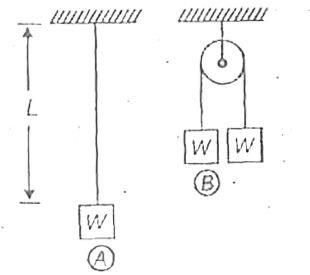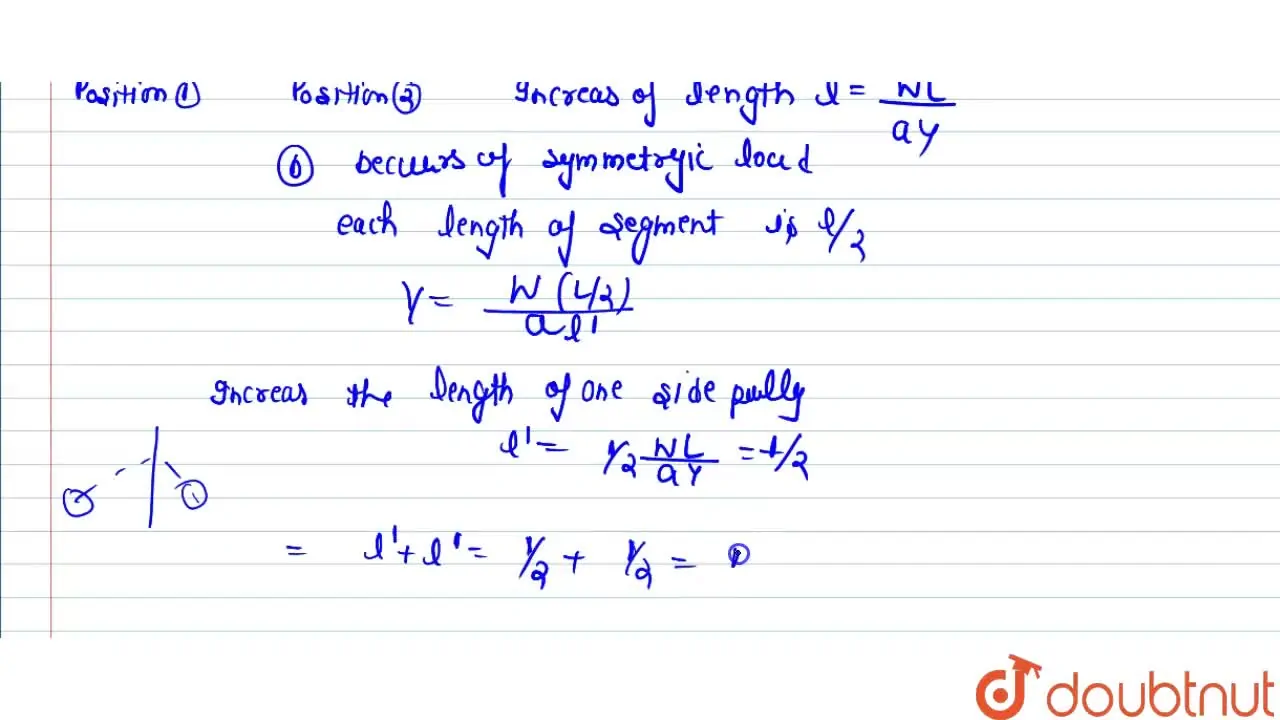When a weight W is hung from one end of a wire of length L (other end being fixed), the length of the wire increases by l. If the same wire is passed over a pulley and two weights W each are hung at the two ends,what will be the total elongation in the wire?

In case a let Y be Young's modulus of the material of the wire. If a is its area of cross section, then we can write
y=F/aF/al/Ll/L=WLal⟨'F=W)
Increase in length of wire l=WLaY
In case b we can treat either segment of length L/2 in fig. as if one to its ends is ficed while the other end is attached to the load W because the point M remains stationary i.e., fixed all the time due to symmetrical load. Thus, when the wire is passed over the pulley, let l' be the increase in the length of each segment. Since each segment is of length L/2, we have
Y=W(L/2)al'
Increase in length of wire of one side of pulley l'=12WLaY=l2
Therefore, increase in the length of both segments of the wire =l'+l'=l2+l2=l
so the increase in length remains the same.
Related Playlists
- BOOK - CENGAGE PHYSICS ENGLISHCHAPTER - PROPERTIES OF SOLIDS AND FLUIDSEXERCISE - Solved Examples11videos
PROPERTIES OF SOLIDS AND FLUIDS
- BOOK - CENGAGE PHYSICS ENGLISHCHAPTER - PROPERTIES OF SOLIDS AND FLUIDSEXERCISE - Exercise 5.112videos
PROPERTIES OF SOLIDS AND FLUIDS
- BOOK - CENGAGE PHYSICS ENGLISHCHAPTER - NEWTON'S LAWS OF MOTION 2EXERCISE - Integer type1videos
NEWTON'S LAWS OF MOTION 2
- BOOK - CENGAGE PHYSICS ENGLISHCHAPTER - RIGID BODY DYNAMICS 1EXERCISE - Integer11videos
RIGID BODY DYNAMICS 1
Similar Questions
A wire elongates by l mm when a load W is hanged from it. If the wire goes over a pulley and two weights W each are hung at the two ends, the elongation of the wire will be (in mm)
View SolutionA wire elongates by 1.0 mm when a load W is hanged from it. If this wire goes over a pulley and two weights W each are hung at the two ends the elongation of the wire will be
View SolutionA wire elongates by l units, when a load w is suspended from it . If the wire gets over a pulley ( equally on both the sides ) and two weights w each are hung at the two ends, the elongation of wire (in units ) will be
View SolutionA body of mass M is attached to the lower end of a metal wire, whose upper end is fixed . The elongation of the wire is l.
View SolutionThe length of a wire increase by 8mm when a weight of 5 kg is hung. If all conditions are the same but the radius of the wire is doubled, find the increase in length.
View SolutionA load w is suspended from a wire of length l and area of cross-section A. Change in length of the wire is say Δl. Change in length Δl can be increased to two times by increasing
View SolutionIf in case A, elongation in wire of length L is l then for same wire elongation in case B will be
 View Solution
View SolutionWhen a steel wire fixed at one end is pulled by a constant force F at its other end , its length increases by l.Which of the following statements is not correct?
View SolutionWhen a load W is hung from a wire, it extends by Δl. The heat produced in the process is
View SolutionA metal wire of length L is suspended vertically from a rigid support. When a bob of mass M is attached to the lower end of wire, the elongation of the wire is l:
View Solution


